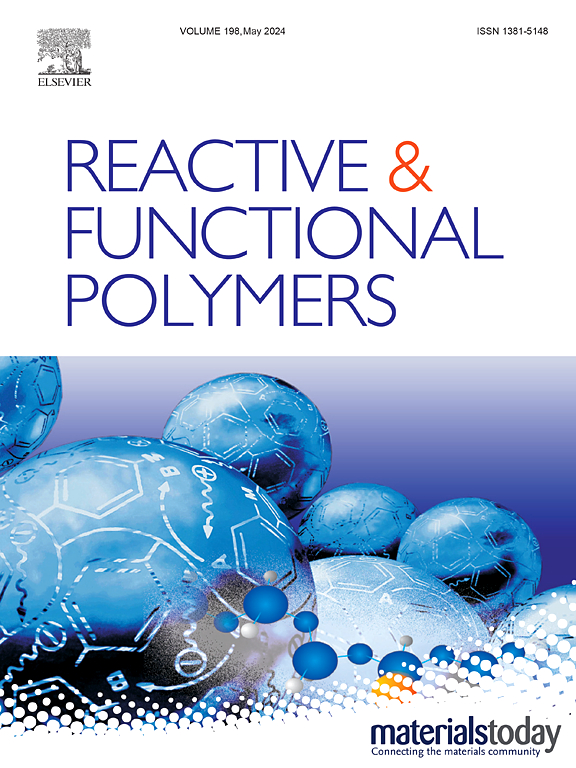Controlling the solvent, surfactant and ion-regulated swelling and elastic response of anionically-modified poly(N-isopropylacrylamide)-based hybrids through simultaneous macromolecular crowding
IF 5.1
3区 工程技术
Q1 CHEMISTRY, APPLIED
引用次数: 0
Abstract
An investigation is presented on how the ion specificities of anionically-modified thermosensitive hybrid systems formed by covalently cross-linked chains in presence of macromolecular crowding agent are affected by ion-pairing interactions. The effects of divalent and monovalent cations on poly(N-isopropylacrylamide-co-methacrylic acid)/polyacrylamide gels having controlled physical/mechanical properties were quantitatively investigated. A systematic investigation on solvent-composition induced transition of thermosensitive hybrids was performed in water–organic solvent (acetone, methanol, ethanol, and 2-propanol) mixtures. The volume fraction of solvent at which swelling of hybrids is minimum in co-nonsolvency zone varied and based on hydrophobicity and carbon chain length of alcohol, the swelling followed decreasing order; methanol > ethanol >2-propanol. The increase in both salt concentration and PAAm content in the precursor solution resulted in “salting out” behavior. The swelling was higher in presence of Cl− anions compared to SO42− anions and followed decreasing order for cations: Na+ > K+ > Mg2+. Salt-treatment caused significant changes in elasticity and swelling, while the elasticity of hybrids was correlated with alteration of salt concentration upon swelling in presence of kosmotropic ions. Surfactants interacted with hybrid system strongly enough to change the macroscopic properties. The swelling was lowest in cationic cetyl trimethylammonium bromide and cetyltrimethylammonium chloride solutions, while a greater swelling was observed in anionic sodium dodecylsulfonate solutions. A perspective for the molecular-specific nature of anionically modified poly(N-alkylacrylamide)-based hybrids is presented for potential applications to evaluate a wide range of surfactant, solvent and salt interactions.

通过同时大分子拥挤控制阴离子修饰聚n-异丙基丙烯酰胺杂化物的溶剂、表面活性剂和离子调控的溶胀和弹性响应
研究了在大分子拥挤剂存在下,共价交联链形成的阴离子改性热敏杂化体系的离子特异性如何受到离子对相互作用的影响。定量研究了二价阳离子和单价阳离子对具有可控物理力学性能的聚(n -异丙基丙烯酰胺-共甲基丙烯酸)/聚丙烯酰胺凝胶的影响。在水-有机溶剂(丙酮、甲醇、乙醇和2-丙醇)混合物中,系统地研究了溶剂组成诱导的热敏杂化物的转变。共不溶区溶胀最小的溶剂体积分数不同,根据醇的疏水性和碳链长度,溶胀大小依次递减;甲醇比;乙醇在丙胺。前驱体溶液中盐浓度和PAAm含量的增加导致了“盐析”行为。与SO42−阴离子相比,Cl−阴离子存在时溶胀率更高,阳离子的溶胀率依次递减:Na+ >;K +比;Mg2 +。盐处理引起了弹性和溶胀的显著变化,而在嗜宇宙离子存在下,溶胀后的弹性与盐浓度的变化有关。表面活性剂与杂化体系的相互作用足以改变其宏观性质。在阳离子十六烷基三甲基溴化铵和十六烷基三甲基氯化铵溶液中溶胀最小,而在阴离子十二烷基磺酸钠溶液中溶胀较大。对阴离子修饰的聚n -烷基丙烯酰胺基杂化物的分子特异性进行了展望,提出了其在评价表面活性剂、溶剂和盐的相互作用方面的潜在应用。
本文章由计算机程序翻译,如有差异,请以英文原文为准。
求助全文
约1分钟内获得全文
求助全文
来源期刊

Reactive & Functional Polymers
工程技术-高分子科学
CiteScore
8.90
自引率
5.90%
发文量
259
审稿时长
27 days
期刊介绍:
Reactive & Functional Polymers provides a forum to disseminate original ideas, concepts and developments in the science and technology of polymers with functional groups, which impart specific chemical reactivity or physical, chemical, structural, biological, and pharmacological functionality. The scope covers organic polymers, acting for instance as reagents, catalysts, templates, ion-exchangers, selective sorbents, chelating or antimicrobial agents, drug carriers, sensors, membranes, and hydrogels. This also includes reactive cross-linkable prepolymers and high-performance thermosetting polymers, natural or degradable polymers, conducting polymers, and porous polymers.
Original research articles must contain thorough molecular and material characterization data on synthesis of the above polymers in combination with their applications. Applications include but are not limited to catalysis, water or effluent treatment, separations and recovery, electronics and information storage, energy conversion, encapsulation, or adhesion.
 求助内容:
求助内容: 应助结果提醒方式:
应助结果提醒方式:


